The way ahead
- Since tigers and elephants are flagship species that influenced the IEDP’s selection of Periyar, the monitoring of these species inside the reserve should also have been prioritized. While the monitoring of socio-economic indicators is essential to measure project success or failure, placing over-emphasis on the socio-economic indicators detracts from the project’s conservation focus, making it more of a rural development project.
- Economic opportunities, not those based on natural resources will determine whether demands for forest resources from surrounding communities go down. If the aim is to turn the dependency of communities away from the forest, enhancing formal education levels of surrounding communities must be considered a serious solution. It is on such directions that rural development activities should focus, because these are what will bring better paid, typically off-farm jobs to locals.
- There is another critical issue. Rural development activities need distinctive skills and expertise and highly motivated and committed individuals. For longer-term success of ICDP activities such as the IEDP, those chosen to implement schemes should be specialists recruited from rural development organisations and departments – whose assessments are based on social parameters – and not through the forest department. Park managers and staff could cooperate with them, but their primary wildlife protection role should not be diluted, or shifted to rural development.
- It is critical that the social acceptability of any such initiatives are assessed by independent agencies if we want unbiased evaluations.
- Another hard fact that emerged from the study was that the tourism industry, which profits the most from the PTR contributes relatively little towards its conservation. Tourism has also provided all too few livelihood benefits to local communities, when compared to the financial benefits it reaps. Revenues need to be channeled from the tourism industry (hotel and resort owners, restaurants, souvenir shops, travel agents and others) for conservation.
Positive Aspects of the Periyar Tiger Reserve-IEDP
The project addressed several concerns and issues raised by critics of earlier ICDPs such as a failure to adopt a participatory approach, social equity, the absence of joint- management systems and the trend of gifting infrastructure without local consultation. Gender empowerment was another major problem area that the project had taken into account. I also saw a unique eco-development fund collected from tourists in place, which was being utilised for the functioning of EDC activities, post-IEDP.
A committed network of individuals from local communities who worked as coordinators (termed as non-governmental individuals) with strong social skills provided a key link between the communities and the project. The involvement and interest of senior forest department officers during the project implementation phase had a considerable and positive impact on project development. Functioning of forest department officials was transparent and the staff of the Periyar Foundation had a positive influence on the implementation.
First published in 2008 as ‘Evaluating the legacy of an integrated conservation and development project around a tiger reserve in India’ by Sanjay Gubbi (Wildlife Conservation Society-India Program, Centre for Wildlife Studies), Matthew Linkie and Nigel Leader-Williams (Durrell Institute of Conservation and Ecology, University of Kent, Canterbury, UK) in Environmental Conservation 35 (4).


 CI is a non-profit, non-commercial portal that aims to facilitate wildlife and nature conservation by providing reliable information and the tools needed to campaign effectively.
CI is a non-profit, non-commercial portal that aims to facilitate wildlife and nature conservation by providing reliable information and the tools needed to campaign effectively.